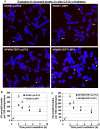Epstein-Barr virus-encoded latent membrane protein 1 impairs G2 checkpoint in human nasopharyngeal epithelial cells through defective Chk1 activation
- PMID: 22761726
- PMCID: PMC3382577
- DOI: 10.1371/journal.pone.0039095
Epstein-Barr virus-encoded latent membrane protein 1 impairs G2 checkpoint in human nasopharyngeal epithelial cells through defective Chk1 activation
Abstract
Nasopharyngeal carcinoma (NPC) is a common cancer in Southeast Asia, particularly in southern regions of China. EBV infection is closely associated with NPC and has long been postulated to play an etiological role in the development of NPC. However, the role of EBV in malignant transformation of nasopharyngeal epithelial cells remains enigmatic. The current hypothesis of NPC development is that premalignant nasopharyngeal epithelial cells harboring genetic alterations support EBV infection and expression of EBV genes induces further genomic instability to facilitate the development of NPC. The latent membrane protein 1 (LMP1) is a well-documented EBV-encoded oncogene. The involvement of LMP1 in human epithelial malignancies has been implicated, but the mechanisms of oncogenic actions of LMP1, particularly in nasopharyngeal cells, are unclear. Here we observed that LMP1 expression in nasopharyngeal epithelial cells impaired G2 checkpoint, leading to formation of unrepaired chromatid breaks in metaphases after γ-ray irradiation. We further found that defective Chk1 activation was involved in the induction of G2 checkpoint defect in LMP1-expressing nasopharyngeal epithelial cells. Impairment of G2 checkpoint could result in loss of the acentrically broken chromatids and propagation of broken centric chromatids in daughter cells exiting mitosis, which facilitates chromosome instability. Our findings suggest that LMP1 expression facilitates genomic instability in cells under genotoxic stress. Elucidation of the mechanisms involved in LMP1-induced genomic instability in nasopharyngeal epithelial cells will shed lights on the understanding of role of EBV infection in NPC development.
Conflict of interest statement
Figures




Similar articles
-
Regulation of DNA Damage Signaling and Cell Death Responses by Epstein-Barr Virus Latent Membrane Protein 1 (LMP1) and LMP2A in Nasopharyngeal Carcinoma Cells.J Virol. 2015 Aug;89(15):7612-24. doi: 10.1128/JVI.00958-15. Epub 2015 May 13. J Virol. 2015. PMID: 25972552 Free PMC article.
-
Activation of the FGFR1 signalling pathway by the Epstein-Barr virus-encoded LMP1 promotes aerobic glycolysis and transformation of human nasopharyngeal epithelial cells.J Pathol. 2015 Oct;237(2):238-48. doi: 10.1002/path.4575. Epub 2015 Aug 3. J Pathol. 2015. PMID: 26096068
-
Alterations of biologic properties and gene expression in nasopharyngeal epithelial cells by the Epstein-Barr virus-encoded latent membrane protein 1.Lab Invest. 2003 May;83(5):697-709. doi: 10.1097/01.lab.0000067480.44925.10. Lab Invest. 2003. PMID: 12746479
-
EBV Infection and Glucose Metabolism in Nasopharyngeal Carcinoma.Adv Exp Med Biol. 2017;1018:75-90. doi: 10.1007/978-981-10-5765-6_6. Adv Exp Med Biol. 2017. PMID: 29052133 Review.
-
Pathogenic role of Epstein-Barr virus latent membrane protein-1 in the development of nasopharyngeal carcinoma.Cancer Lett. 2013 Aug 28;337(1):1-7. doi: 10.1016/j.canlet.2013.05.018. Epub 2013 May 17. Cancer Lett. 2013. PMID: 23689138 Review.
Cited by
-
Modulation of DNA damage and repair pathways by human tumour viruses.Viruses. 2015 May 22;7(5):2542-91. doi: 10.3390/v7052542. Viruses. 2015. PMID: 26008701 Free PMC article. Review.
-
Influence of pathogens on host genome and epigenome in development of head and neck cancer.Cancer Rep (Hoboken). 2023 Nov;6(11):e1846. doi: 10.1002/cnr2.1846. Epub 2023 Jun 15. Cancer Rep (Hoboken). 2023. PMID: 37322598 Free PMC article. Review.
-
Nasopharyngeal Carcinoma Progression: Accumulating Genomic Instability and Persistent Epstein-Barr Virus Infection.Curr Oncol. 2022 Aug 23;29(9):6035-6052. doi: 10.3390/curroncol29090475. Curr Oncol. 2022. PMID: 36135044 Free PMC article. Review.
-
Role of Epstein-Barr Virus in the Pathogenesis of Head and Neck Cancers and Its Potential as an Immunotherapeutic Target.Front Oncol. 2018 Jul 6;8:257. doi: 10.3389/fonc.2018.00257. eCollection 2018. Front Oncol. 2018. PMID: 30035101 Free PMC article. Review.
-
The role of Epstein-Barr virus in nasopharyngeal carcinoma.Front Microbiol. 2023 Feb 9;14:1116143. doi: 10.3389/fmicb.2023.1116143. eCollection 2023. Front Microbiol. 2023. PMID: 36846758 Free PMC article. Review.
References
-
- Young LS, Rickinson AB. Epstein-Barr virus: 40 years on. Nat Rev Cancer. 2004;4:757–768. - PubMed
-
- Busson P, Keryer C, Ooka T, Corbex M. EBV-associated nasopharyngeal carcinomas: from epidemiology to virus-targeting strategies. Trends Microbiol. 2004;12:356–360. - PubMed
-
- Chan AS, To KF, Lo KW, Ding M, Li X, et al. Frequent chromosome 9p losses in histologically normal nasopharyngeal epithelia from southern Chinese. Int J Cancer. 2002;102:300–303. - PubMed
-
- Lo KW, To KF, Huang DP. Focus on nasopharyngeal carcinoma. Cancer Cell. 2004;5:423–428. - PubMed
Publication types
MeSH terms
Substances
LinkOut - more resources
Full Text Sources
Other Literature Sources
Molecular Biology Databases
Research Materials
Miscellaneous

